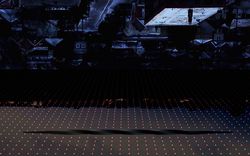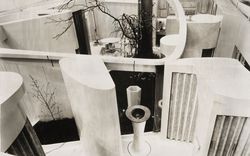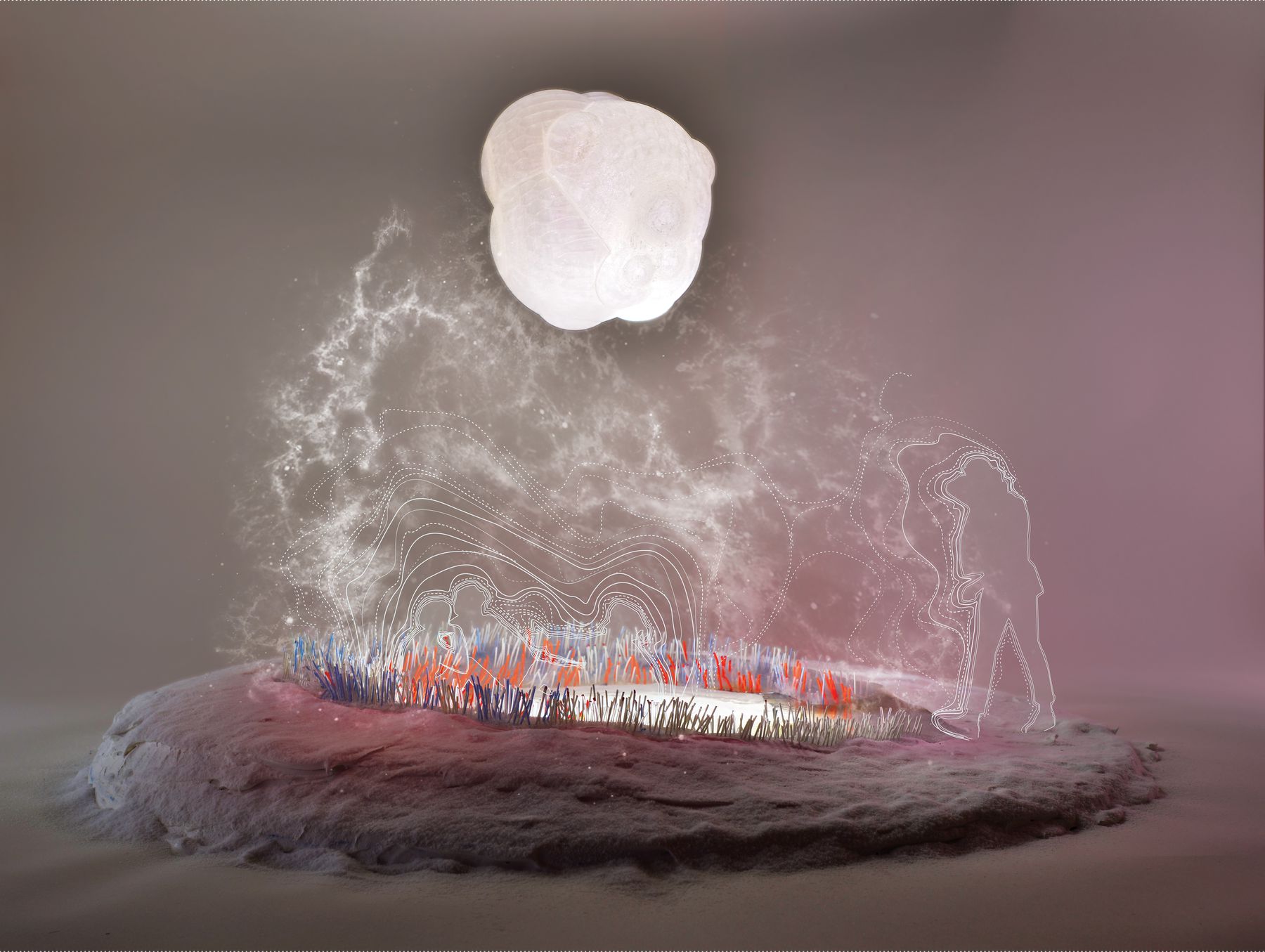2017: Thanks for Asking, Larry
A fictional response to an actual question, by Sean Lally
“If you had $50 million, what would you spend it on? Tell me what we should be doing.”
—Larry Page1
On a few occasions, I had submitted requests for press credentials to try to attend these types of conferences, with no luck. And by “these types of conferences,” I’m referring to ones defined as much by their locations—private resorts with good weather and high price tags—as by their impressive lists of invitees. Because I had never gotten in, I had no way of knowing if you even get much of a chance to interact with these presumably well-paid speakers. After calling in a few favours, I did finally manage to attend one particular event—and I can tell you that catching a little quality time with the guests there isn’t a problem.
This particular gathering has no online press-access form. The Science Foo Camp, or Sci Foo for short—not to be confused with the television channel Syfy, the music group the Foo Fighters, or a somehow-yet-unmade movie starring Pauly Shore called Science Camp—is a private, annual meeting that has taken place since 2006. It has heavy ties to Google and the Nature Publishing Group. It’s invitation only, with a guest list primarily representing the sciences and technology. What makes it unique, probably, is that there’s no agenda outlined prior to everyone arriving, and there are no repeat guests. If I were feeling a little cynical, I’d say it’s a well-funded focus group.
The event is intended to feel spontaneous and informal, with many small conversations among various smart people. And that’s more or less what I was seeing as the day began, in a lobby area that opened onto an outdoor terrace overlooking an unnaturally green lawn at the Googleplex facilities in Mountain View. These are not particularly impressive spaces compared to the beauty of their surroundings. It might be a site of innovation, where various gadgets are imagined and shaped, but it looks more like the Best Buy where they used to be sold.
As a guest of a guest who finagled himself in, I was a little hesitant to initiate a conversation with those around me. I figured it might be best to float around in hopes of overhearing something interesting.
In any case, the event happened and I was there.
Read more
Even though I had studied the names of the guests, as well as their exhaustive accomplishments, I was having difficulty matching photographs with the people standing around me. Aging faces, and unexpected heights and weights, were making it difficult to identify whom I was looking at. And that’s probably why I was unclear on who stood in the little circle I gingerly wedged my way into.
“If you had $50 million, what would you spend it on? Tell me what we should be doing.”
I was clearly stepping in on an ongoing conversation, because this sounded less like a genuine question than a defensive statement to a comment I had just missed. I’ll spare you the mental pieces I puzzled together, but I eventually recognized that the guy speaking was Larry Page, co-founder of Google and CEO of its parent company, Alphabet.
I also quickly realized I had misread the situation. This was someone being a bit theatrical with a friend or colleague in the group, for the entertainment of the few others gathered around who didn’t know each other. And it worked.
Looking around the circle, I saw mostly grins from people who I could only imagine have spent decades invested in their areas of research, who undoubtedly had a response to this question—yet had refrained from answering it. Maybe the question was so direct that no one felt ready to speak up. Maybe they thought it was rhetorical. More likely, maybe the coffee hadn’t been flowing long enough to fire up everyone’s little grey cells.
But I believe the desired response is what is referred to as an elevator pitch. You’re stuck on an elevator—either by coincidence or by elaborate orchestration—with someone you’ve been hunting down for a conversation, and you have about fifteen seconds between floors to lay out why this person should invest in you and your ideas. But that wasn’t what was happening. It was uncomfortably quiet.
Here’s what was running through my head: What’s the answer, people? Get on with it. This is what I’ve been waiting for, and somehow I’m getting my wish just fifteen minutes in.
I hadn’t come with an elevator pitch. I had a very loose understanding of a few trends occurring in the tech world as it relates to environmental issues such as climate change and alternative energy sources. These were smart people at the pinnacles of their various disciplines. Most were involved in the sciences or engineering, but not necessarily directly tied to the start-ups one associates with the Bay area. Some worked out of university labs, others for large or “slightly less large” corporations. Some were even writers who report on or discuss these issues in magazines and books.
The question that Larry was asking could very well have been the slogan for the conference. It was a question that seemed simply to ask, “Where should Google invest our billions of excess dollars so we can stay on top of the next trends just over the horizon?” And while that was probably true in some way, I think he was also saying, “We at Google have the resources to tackle big problems affecting this world, and there’s no shortage of those problems, so tell me what you’re currently working on and maybe we can throw our weight behind your efforts.”
There was no question that the people here were thinking big picture, and the initial volleys fit squarely in the realm of either making a difference for the environment (clean energy, environmental radiation, geoengineering) or trying to get ahead of technological change that simply can’t be ignored (artificial intelligence). These were great answers, and Larry looked fully invested in what he was hearing. But not surprisingly, the success of each proposal revolved around solving a technological problem: a more efficient way to harness energy from the sun, a better battery to store that energy, and so on.
I was piqued. To be completely honest, my interest in being there had less to do with hearing how industry leaders were thinking of solving any of these problems, and more to do with seeing if their courses of action were shifting in any way.
Let me explain. Google isn’t new to confronting questions related to climate change. In 2007, Google set up its own R&D division called RE<C to tackle exactly these problems. Its mandate was to see if it was possible to generate renewable power more cheaply than with coal-fired plants, essentially paving the way for the adoption of these techniques by industries worldwide. The short version of this story is that they shut the operation down after only four years. In the process they discovered that even with their most ambitious projections for CO2 reduction—through the use of advanced technologies they still hadn’t uncovered—climate change could not be curbed entirely. As it turned out, much of the discussion revolved around incentivizing industries to abandon a fossil-fuel infrastructure in which they’ve invested billions for renewable resources. And as of now, the math just doesn’t work out.
This conclusion from Google was brutal, and it seemed to drive home the point that technology alone isn’t going to solve our problems. Actually, it showed that even a confluence of technology, policy change, and money still wouldn’t be enough to shift course and avoid outcomes that appear to be inevitable.
I thought, Let’s just see where this goes.
“Are you all familiar with Oliver Morton? He’s the briefings editor of The Economist and has written a few books, including Eating the Sun and The Planet Remade,” I offered.
I got a nod or two. Maybe because they read the books or, more likely, they were motioning that I should continue.
“In any case, the books are quite good. They do more than provide cursory explanations for these complex situations. But what I found particularly interesting was a distinction he makes about energy transitions. I believe it was Arnulf Grubler who originally made this observation. Energy transitions take decades, if not a century, to fully occur. More importantly, Grubler makes a distinction between ‘pulling’ and ‘pushing’ these transitions. What I mean to say is, if you push people to transition from coal to oil simply on the basis of a moral good or an efficiency model, you’re going to run into resistance, and the transition will take longer than if you pull them into it—by saying, for example, we have this thing called a car that moves people around in ways a horse and carriage can’t. They’re fast, they drive on the same roads that our horses do, and they look amazing! They also happen to run on oil, which we’re going to have to transition to… Anyway, pulling by demand, not pushing by supply. What I’m hearing here is a lot of talk about pushing. Have you given any thought about how to pull people into the twenty-first century with respect to energy use and climate change? And not just in terms of potential energy sources, but what we might be able to do with that energy?”
I realized I left this rather open-ended. Winding down, I felt reminded that the spirit of the conversation was to offer solutions to these questions, not complain about our problems. So I did my best to spin my comment into a question in hopes of getting a response.
“Pulling influence…managing expectations and behaviour? This sounds like quite a social experiment you’re looking to run,” Larry replied. He had a smile on his face, which immediately transferred onto mine. That little smile was now on all our faces, compelling me to follow up.
This wasn’t a completely unfamiliar situation. How many times have you as an architect talked to someone on the periphery of the discipline (people at community town halls, leaders of non-profit institutions, curators, etc.) only to realize your seemingly clear line of thinking is not translating? Same thing here. I wasn’t there to give a “pitch.” He asked a direct question, and I needed to give him a direct answer.
“Yes,” I said. “But I’m not sure I would characterize it that way.”
I knew, of course, that Larry probably wouldn’t either; I assumed he was just trying to have a little fun.
“To answer your question—what I would do with $50 million—I think the answer is education. Not in terms of schooling, so people know more about the science and engineering that inform their lives. I’m talking about shaping expectations about our futures. Providing a form of inspiration to people about what our global environments and lifestyles could look like twenty-five to fifty years from now.
“What I’m saying is that global warming, our energy sources—all these questions—need to be addressed on multiple fronts. Technological solutions are one of those fronts, but not the only one. Focusing solely through the lens of the technological gives the impression that we have a problem that can be fixed. And when a problem is believed to be fixable, we assume the solution gives us something that looks like the world did prior to the problem.”
“OK,” said Larry. “But you still haven’t answered my question.”
“Take the $50 million and fund five hundred design projects that show a future that takes into account environmental change and all that goes along with it—climate change, the bioengineering of our bodies, new uses for energy—and then get them in front of the general public. These designs could be physical spaces people visit, stories people can read, movies people can watch. I’m not talking about dystopian warnings or guilt trips about lessons we should have learned in the past. I’m talking about providing images that stimulate and prepare people for the future ahead. Tomorrow isn’t going to look like yesterday, and as long as we continue to judge its success and appeal based on a belief that it will, we’re in for disappointment.”
“Give me an example of how this works. Point to something that has done this in the past,” he countered.
“You need to bring architects in. That’s what I’m getting at. And not to build you a new facility but to do the work inside those facilities,” I replied. “A good example of would be the architect Cedric Price and the Fun Palace, a project he initiated with the theatre director Joan Littlewood. This was a project without a client or even a site, in the beginning. Price intertwined a wide range of contemporary discourse and theories including cybernetics, information theory, and even theatre in an interactive public space. He collaborated with people like Gordon Pask and Norbert Wiener. And though the project was never built, it had immense influence on many architects’ work. No doubt it even informed the research of his collaborators. This is because it was more than a design exercise that saw its way into a few architecture publications—it was a project that went on for close to a decade and involved not only a large, diverse team but also politicians, developers, and financiers. The Fun Palace pulled our profession forward and did the same for anyone that took the time to understand its social objectives.
“Norman Bel Geddes’s work for the General Motors Pavilion at the 1939 World’s Fair is another. Of course, it had this stimulating effect for oil-fueled cars and paved roads. But its projected futures—complete with models of suburbs, motorways, and cloverleaf overpasses—had a huge impact on the people visiting the fair.
“Our evolving environment and crises of clean energy aren’t issues that should be presented as simply ‘fixable’ any more. That approach is beginning to feel disingenuous.” Everyone stared.
“What would we be doing if we weren’t looking to fix a bad situation? Not pursuing a fix would be seen as negligent,” Larry countered.
“I realize that as a business you have to be careful about public opinion and the optics of what you’re doing,” I said. “You’re probably struggling with a false dichotomy—people see large corporations as either part of the solution or part of the problem. But I think you could view my answer as yet another front in a complex discourse that needs to be opened up.”
Larry slowly handed his coffee to the person on his right and brought his hands back together. He looked back at me; he was calm. Using the index finger and thumb of his right hand, he pinched the webbing of skin between his left thumb and index finger as if carefully squeezing something in precisely that spot.
And just like that, Larry was gone. Not in a flash, not with a pop—just…not there. We could immediately hear his voice from behind us as he joined another group’s conversation twenty feet away. “If you had $50 million, what would you spend it on? Tell me what we should be doing.”
Google clearly has some crazy stuff under wraps. Those of us left in the circle just stared at each other, some looking less surprised than others.
All I could think to say was, “Who do I talk to about that $50 million?”
-
This question was overheard at a Sci Foo event by the writer David Biello. Quoted in David Biello, The Unnatural World: The Race to Remake Civilization in Earth’s Newest Age (New York: Scribner, 2016), 152. ↩
Sean Lally is an architect and Associate Professor at the School of Architecture of the University of Illinois at Chicago. He is the host of the podcast Night White Skies.














